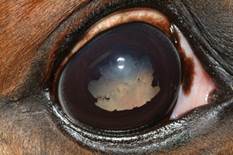Equine - Timely Topics
Equine Recurrent Uveitis, Or “Moon Blindness”
Jessica Meekins, DVM, MS, Diplomate ACVO, Assistant Professor of Ophthalmology

Equine recurrent uveitis (ERU), also known as Moon Blindness or Periodic Ophthalmia, is a leading cause of blindness in horses worldwide. It is one of the most common diseases of the equine eye, with an estimated prevalence of 2-25% in the United States. Equine recurrent uveitis is characterized by inflammation occurring inside the eye, first impacting the uveal tract (termed uveitis). The uveal tract consists of vascular tissues inside the eye essential to proper nourishment and function of the eye.
Signs of ERU
The symptoms observed by owners are often subtle and can range from very mild tearing or swelling of the eyelids, to more obvious squinting and noticeable change in appearance (cloudiness) of the eye. One or both eyes can be affected, and though any horse can be diagnosed with ERU, at risk breeds include Appaloosas, European warm bloods, and draft breeds. To date, however, there is no definitive evidence that the disease is genetically inherited.
Equine recurrent uveitis is not considered contagious, meaning that it cannot be spread from one horse to another. The underlying cause for ERU is controversial and has been debated for decades. Historically, exposure to a bacterium called Leptospira has been implicated as an infectious cause. Leptospirosis is a bacterium carried by several wildlife hosts and shed in the urine of infected animals. This may be a predisposing factor in some horses, and infection with this bacterium seems to be more common in horses diagnosed with ERU in Europe than in American horses. Possible but less likely additional causes are other infectious agents (viruses, parasites, fungi) or trauma. Our understanding of the ERU disease process is constantly evolving and ERU is an area of intense research within veterinary ophthalmology. To date, we do know that there is a strong immune-mediated component (meaning that the horse’s body develops an overactive immune response directed against the inner tissues of the eye).
Persistence and Treatment
By definition, horses affected by ERU will experience multiple bouts of active disease. The frequency and severity of episodes is variable and depends on each individual horse. Some veterinarians will choose to perform specific diagnostic tests screening for infectious causes such as Leptospirosis, after performing an eye exam on your horse. Initiating treatment for ERU early on in the active period is critical to minimizing complications associated with the disease. However, while the symptoms associated with ERU are very similar to those seen with corneal ulcers and abscesses (other common diseases of the equine eye), treatment for these eye diseases is vastly different. It is important that a veterinarian evaluate your horse prior to initiating any treatment to ensure a proper diagnosis.
We typically start with medical therapy to treat horses experiencing active episodes of ERU. Treatment consists of topical and systemic (oral) anti-inflammatory medications. If there is a suspicion of bacterial infection, some veterinarians will additionally prescribe an antibiotic. There are also alternative therapies for ERU; one option available in the United States and offered here at KSU is a cyclosporine implant. A small disc-shaped implant filled with a medication called cyclosporine is surgically implanted within the white layer (sclera) of the eye. The implant then slowly releases the medication, which is an anti-inflammatory/immune-modulatory drug. A major goal of the cyclosporine implant is to reduce the requirement of topical and oral medications in horses treated with this procedure.
Unfortunately, the long term prognosis for the eye (maintaining vision and comfort) in horses diagnosed with ERU is guarded. Some horses respond favorably to treatment, while others develop secondary problems related to the inflammation inside the eye. These include cataract (cloudiness or opacity of the lens), glaucoma (elevation of eye pressure), shrinkage of the eye, and retinal damage, all of which result in blindness and are difficult to treat. Early recognition and treatment intervention are important in an effort to maximize the amount of time a horse retains vision and comfort of the affected eye(s).